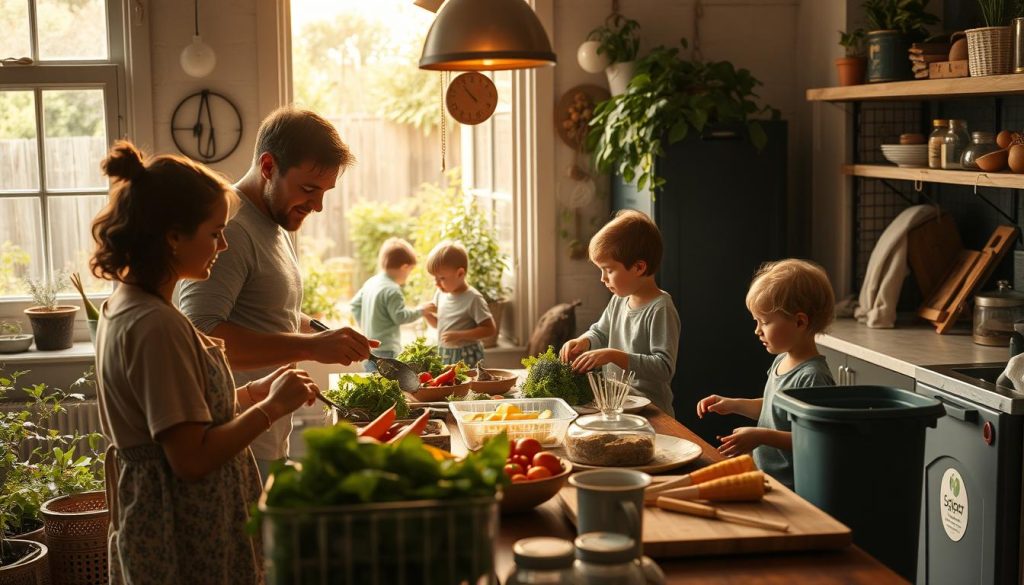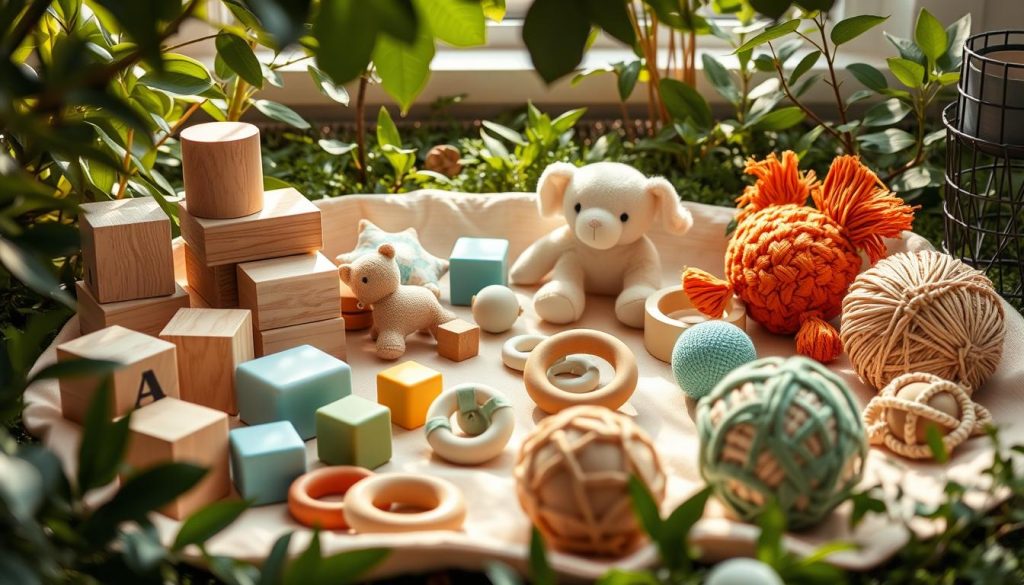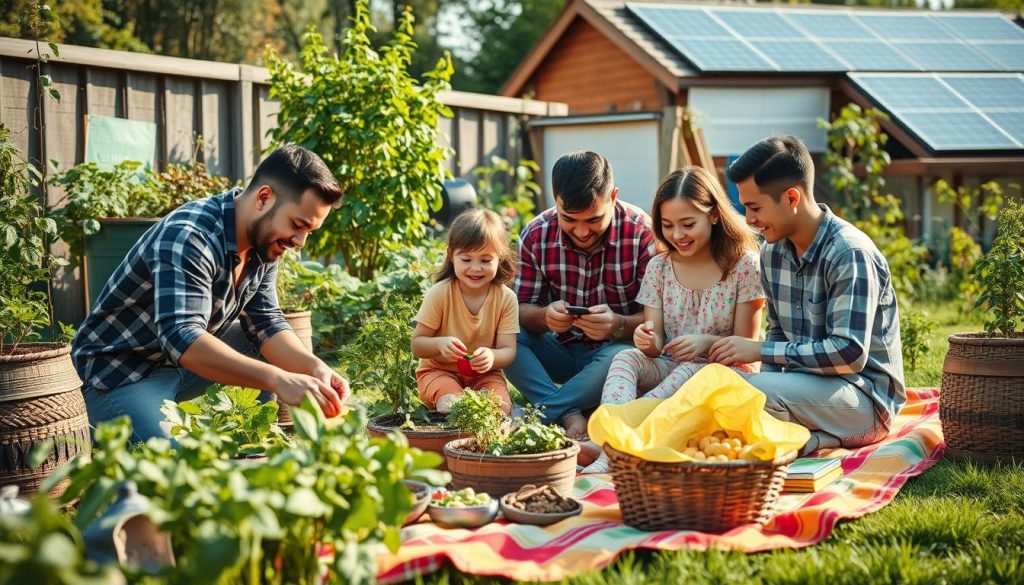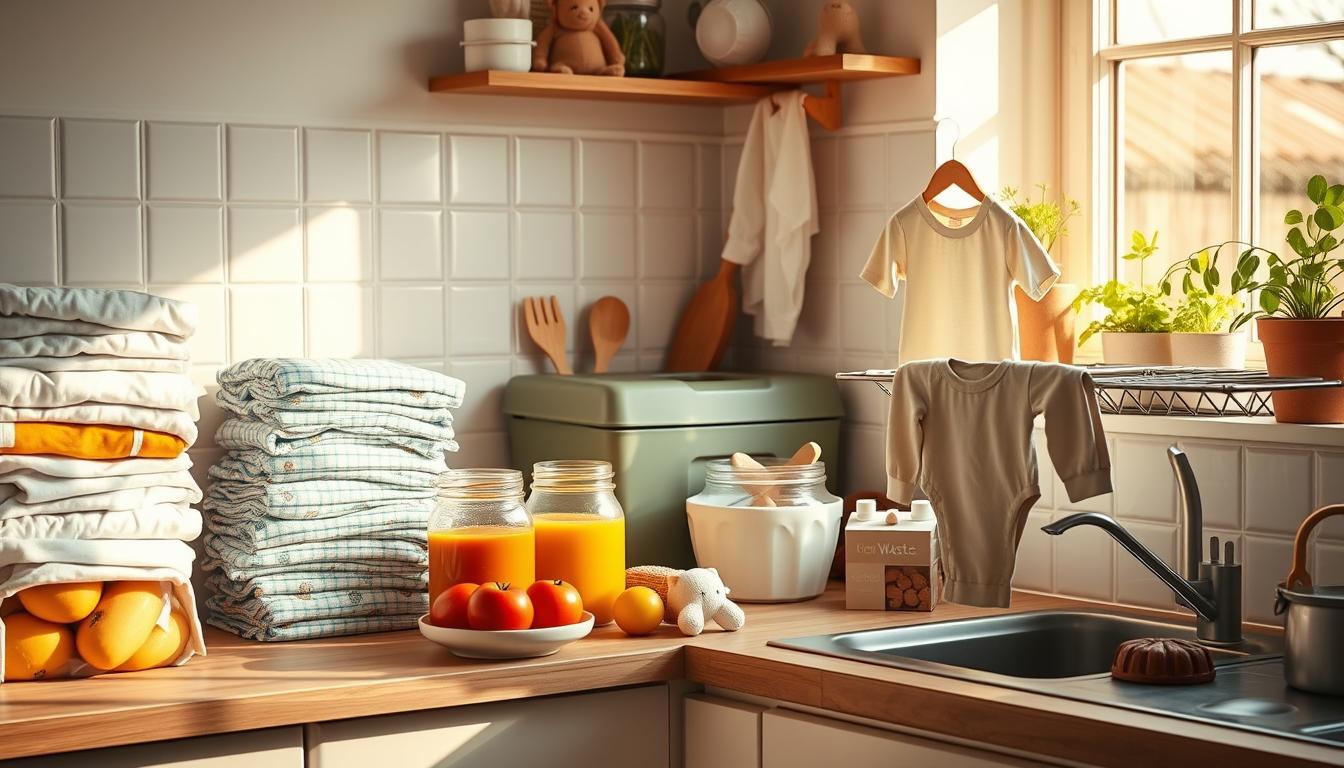I’ve started a journey in zero waste parenting and I’m eager to share it with you. This way of raising a family aims to lessen our environmental footprint. It also makes our home healthier for our kids.
Sustainable family living is more than a trend; it’s crucial for our planet’s future. By changing our daily habits, we can cut down on waste. We also teach our kids about caring for the environment.
In this guide, I’ll show you easy tips and strategies for zero waste parenting. We’ll look at eco-friendly baby items and sustainable meal planning. You’ll see how to make your home greener without losing comfort or ease.
Let’s explore zero waste parenting together. We’ll learn how to positively impact our families and the planet.
Understanding Zero Waste Parenting: A Sustainable Approach
Zero waste parenting is a lifestyle that helps the environment while raising kids. It’s not just about using green products. It’s about making our homes better for our children and the planet.
This approach means using less, reusing more, and recycling when we can. It’s different from old ways that use a lot and throw away a lot.
Zero waste parenting aims to fix problems caused by old ways of raising kids. Using cloth diapers, cloth wipes, and green food options cuts down our waste a lot.
| Traditional Parenting | Zero Waste Parenting |
|---|---|
| Disposable diapers | Cloth diapers |
| Single-use wipes | Reusable cloth wipes |
| Plastic baby bottles | Glass or stainless steel bottles |
| Store-bought baby food | Homemade baby food |
Choosing zero waste parenting doesn’t mean giving up on ease or quality. Many green products work just as well as the old ones. By making smart choices, we teach our kids about caring for the Earth early on.
Getting Started: Eco-Friendly Baby Essentials
Starting your zero waste journey as a new parent can feel overwhelming. I’m here to guide you through the essentials of eco-friendly parenting. Let’s explore sustainable options that are good for your baby and the planet.
Choosing Reusable Diapers and Wipes
Reusable diapers are a game-changer for eco-conscious parents. They come in various styles, from all-in-ones to prefolds. I found cloth diapers not only reduced waste but also saved money in the long run. Pair them with washable wipes made from soft, organic cotton for a complete sustainable diapering system.
Sustainable Feeding Solutions
When it comes to feeding, breastfeeding is the most sustainable option. If you’re using bottles, opt for glass or stainless steel alternatives. As your baby grows, consider making organic baby food at home. It’s fresher, healthier, and generates less packaging waste than store-bought options.
Eco-Conscious Baby Care Products
Look for natural, organic baby care products in recyclable or refillable packaging. I switched to bamboo toothbrushes, plastic-free hair brushes, and organic cotton washcloths. These small changes add up to a significant reduction in plastic waste over time.
- Organic cotton clothing and bedding
- Wooden or silicone teething toys
- Natural rubber pacifiers
- Biodegradable baby wipes for on-the-go
Remember, transitioning to eco-friendly baby essentials doesn’t have to happen overnight. Start with one area, like switching to reusable diapers or making organic baby food, and gradually incorporate more sustainable practices into your routine.
Creating a Minimalist and Sustainable Nursery
I’m excited to share my tips for designing a minimalist nursery that’s both stylish and sustainable. When I started planning my baby’s room, I knew I wanted to create a peaceful space using eco-friendly baby products. The key is to focus on essentials and choose items that are both functional and environmentally conscious.
Start with a neutral color palette. Soft whites, gentle grays, and muted earth tones create a calming atmosphere. These colors also make it easy to add pops of color with accessories as your child grows. For the walls, opt for non-toxic, low-VOC paint to ensure the best air quality for your little one.
When selecting furniture, look for pieces made from sustainable materials like bamboo or reclaimed wood. A convertible crib that transforms into a toddler bed is a smart investment. Choose a dresser that can double as a changing table to maximize space in your minimalist nursery.
- Organic cotton crib sheets and blankets
- Natural fiber rugs
- LED lighting fixtures
- Wooden toys and storage bins
Decor should be simple yet meaningful. Consider framing nature-inspired prints or creating a gallery wall with family photos. A cozy reading nook with a small bookshelf and floor cushions encourages early learning while maintaining the room’s minimalist vibe.
Remember, a clutter-free environment promotes better sleep and reduces stress for both you and your baby. By carefully selecting eco-friendly baby products, you’re creating a healthy, sustainable space for your little one to thrive.
Zero Waste Parenting: Everyday Practices for Eco-Friendly Family Living

Living sustainably is more than just buying green products. It’s about changing our daily habits to reduce waste and use resources wisely. Small changes can have a big effect on our family’s impact on the environment.
Reducing Household Waste
Starting to reduce waste is key in plastic-free parenting. We’ve replaced disposable items with reusable ones, like cloth napkins and beeswax wraps. We also compost and recycle a lot.
Getting my kids involved in sorting recyclables makes it fun. It turns waste reduction into a family activity.
Sustainable Meal Planning and Preparation
Planning meals is a big step towards sustainable living. I plan our meals a week in advance, choosing seasonal, local foods. This way, we use leftovers and freeze food for later.
Buying in bulk with reusable containers also cuts down packaging waste. It’s a big change for the better.
Eco-Friendly Cleaning Solutions
Switching to homemade cleaners has been a big part of our journey. I make all-purpose cleaner with vinegar and citrus peels. Baking soda is great for scrubbing.
These simple changes have reduced harmful chemicals and cut down plastic bottle use. It’s a big win for our home.
By making these changes, we’ve made our home more sustainable. It’s not about being perfect, but about making progress. Every small step helps and teaches our kids valuable lessons.
Sustainable Fashion for Growing Families
I’ve found that sustainable fashion is crucial for eco-friendly family living. As a parent, I’m always searching for ways to lessen our environmental footprint. Secondhand baby clothes are my top choice for dressing my kids responsibly and saving money.
Clothing swaps are a great way to update wardrobes without spending a lot. I host monthly swaps with other parents in my area. We swap outgrown clothes, saving money and cutting down on waste. It’s good for our wallets and the planet!
When I do buy new clothes, I choose ethical brands that focus on sustainability. These brands use organic materials and ensure fair labor practices. This way, our purchases match our values. Here’s a look at traditional vs. sustainable baby clothing:
| Aspect | Traditional Baby Clothes | Sustainable Baby Clothes |
|---|---|---|
| Materials | Synthetic fibers, conventional cotton | Organic cotton, bamboo, hemp |
| Production | Mass-produced, often in poor conditions | Ethically made, fair labor practices |
| Lifespan | Shorter, less durable | Longer-lasting, higher quality |
| Environmental Impact | High water usage, chemical pollution | Reduced water use, eco-friendly dyes |
I also aim for a minimalist wardrobe for my kids. I choose versatile pieces that can be worn in many ways. This not only saves space but also teaches kids about being mindful of what they consume from a young age.
Plastic-Free Parenting: Alternatives to Common Baby Items

I’m excited to share my journey into plastic-free parenting. It’s a challenge, but it’s rewarding to create a healthier environment for our little ones. Let’s explore some great alternatives to common baby items that can help reduce our plastic footprint.
Non-Toxic Toys and Play Materials
When it comes to non-toxic toys, I’ve found some amazing options. Wooden blocks, cloth dolls, and natural rubber teethers are fantastic choices. These toys are not only safe but also stimulate creativity and sensory development. I love watching my child engage with these eco-friendly playthings.
Eco-Friendly Baby Gear
Eco-friendly baby gear has come a long way. I’ve switched to a bamboo baby bathtub, organic cotton swaddles, and a wooden high chair. These items are durable, beautiful, and free from harmful chemicals. It’s a win-win for both my baby and the planet.
Sustainable Gift Ideas for New Parents
When it comes to gifting, I focus on practical and sustainable items. Some of my go-to ideas include:
- Organic cotton baby clothes
- Bamboo diaper subscription
- Homemade baby food vouchers
- Plantable greeting cards
These gifts are thoughtful, useful, and align perfectly with plastic-free parenting values.
Embracing plastic-free parenting has been an eye-opening experience. It’s not always easy, but the benefits for our children and the environment make it all worthwhile. Every small change counts in creating a healthier future for our little ones.
Composting and Recycling: Family-Friendly Waste Management
Living sustainably as a family is more than just using cloth diapers. It’s about being mindful of waste. Composting diapers and food scraps greatly reduces our environmental footprint.
Starting to compost is simpler than you might think. We first used a backyard bin for fruit and veggie scraps. Then, we tried composting diapers. It’s not as bad as it sounds! There are special systems that safely and efficiently break down diapers.
Recycling is also key in our waste management plan. We turned recycling into a family activity with a sorting station in our kitchen. Each bin is colored, making it fun for our kids to help. It’s amazing how quickly they learn and remind us what goes where!
Here are some tips for getting kids involved in reducing waste:
- Make a game out of spotting recyclable items
- Create art projects using recyclable materials
- Start a small herb garden using compost you’ve made together
- Reward eco-friendly behaviors with stickers or extra playtime
By making these habits part of our daily life, we’ve cut down our waste a lot. It’s not just about being green; it’s about teaching our kids important skills. Sustainable living is a journey, and every step we take helps make the future greener.
Teaching Kids About Sustainability: Fun and Educational Activities

Teaching kids about sustainability is key for a greener future. By getting them involved in eco-friendly habits, we raise a planet-conscious generation. Let’s dive into some fun activities that make learning about sustainability both enjoyable and lasting.
Storytelling is a great way to introduce eco-friendly ideas. Books like “The Lorax” by Dr. Seuss start important talks about protecting our environment. We can also start a mini garden in recycled containers. This teaches kids about plants and the value of growing our own food.
Crafting with recyclable materials is another fun way to teach sustainability. We can make toys, decorations, or even eco-friendly baby products from items that would otherwise be thrown away. This not only cuts down on waste but also boosts creativity.
| Age Group | Eco-Friendly Activity | Learning Outcome |
|---|---|---|
| 3-5 years | Sorting recyclables game | Basic waste management |
| 6-8 years | Upcycling craft projects | Resource conservation |
| 9-12 years | Composting workshop | Natural recycling processes |
Outdoor activities are perfect for learning about the environment. Nature walks, beach cleanups, or birdwatching trips help kids see the beauty of nature. These experiences often spark a lifelong dedication to living sustainably.
Navigating Social Pressures and Building a Supportive Community
Starting a zero waste lifestyle can be tough with social pressures. But, finding a supportive community helps a lot. It keeps us going on our eco-friendly path.
Dealing with Unsupportive Family and Friends
When others doubt our choices, I stay calm and share why we’re doing it. I talk about how it helps our planet. Showing them how simple and good it is helps a lot.
Finding Like-Minded Parents and Groups
Meeting other eco-friendly parents changed everything. I joined local groups and went to events. It’s great to get support, tips, and encouragement for our zero waste life.
Balancing Zero Waste Goals with Real-Life Challenges
Trying to be perfect in zero waste parenting is hard. I’ve learned to be okay with not being perfect. It’s about making sustainable choices when we can and moving forward.
- Set realistic goals for your family
- Celebrate small victories in reducing waste
- Be kind to yourself when challenges arise
By facing social pressures and building a supportive community, we can make our zero waste journey better. Every small step towards a greener life counts.
The Financial Benefits of Zero Waste Parenting
Zero waste parenting is good for the planet and my wallet. I’ve seen big savings by choosing eco-friendly baby products and living sustainably. The upfront cost of reusable items is worth it in the long run.
For instance, cloth diapers saved me over $1,500 for one child compared to disposables. Reusable wipes, bottles, and food containers also cut down on waste and purchases.
Living sustainably isn’t just about baby gear. It’s about buying less overall. We focus on a few quality, non-toxic toys that encourage creativity. This approach saves money and keeps our home tidy.
Zero waste parenting reduces our environmental impact and saves money. It’s a win-win that shows sustainable living can be both good for the planet and our budget.
